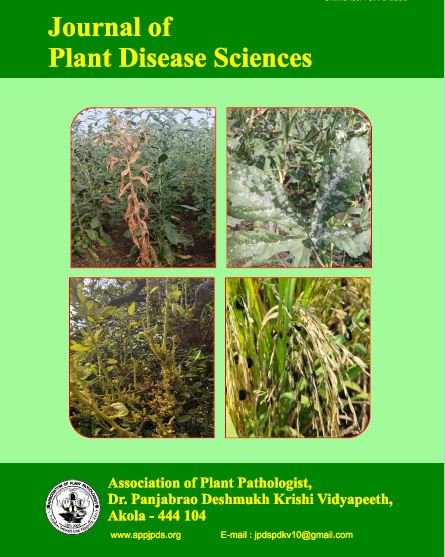CULTURAL AND PHYSIOLOGICAL CHARACTERISTICS OF PYTHIUM SPECIES CAUSING DAMPING-OFF OF ACID LIME
DOI:
https://doi.org/10.48165/jpds.2024.19.02.09Keywords:
Cultural, Pythium deliense, Damping-off, Physiological studiesAbstract
The current study was conducted to investigate the effect of culture media, atmospheric temperature, and relative humidity on the growth and development of Pythium deliense causing damping-off in acid lime.A total of six solid culture media—Oat Meal Agar, Corn Meal Agar, Martin's Rose Bengal Agar, V8 Juice Agar, Malt Extract Agar, and Potato Dextrose Agar—were tested for fungal growth. Among these, Oat Meal Agar, Corn Meal Agar, and Martin’s Rose Bengal Agar were found to be the most suitable, with a maximum radial growth of Pythium deliense (90.0 mm), while the least growth was recorded on Potato Dextrose Agar (27.56 mm).The colony characteristics of Pythium deliense varied across media, exhibiting white-colored, evenly thick to sparse growth with floral patterns. The fungus produced aseptate mycelium and globose-shaped sporangia.Physiological studies revealed that the fungal growth significantly varied with different temperature and relative humidity levels. The optimal growth of Pythium deliense was recorded at 25°C and >85% relative humidity.Acid lime (Citrus aurantifolia Swingle) is an important horticultural crop in various regions, including Akola and Amravati districts, where damping-off disease significantly reduces crop yield and quality.References
Anonymous, 2014. Improved Cultivation Practices for Acid Lime. Extension Bulletin No. 4, ICAR NRCC, Nagpur, pp. 1-52.
Anonymous, 2021. Relative humidity and plant media favorable for the growth of Pythium aphanidermatum, a Telluric pathogen of growth. Available at: https://www.agritech.tnau.ac.in.
Anonymous, 2022-23. Acid lime production in Amravati division. Available at: https://www.krishi.maharashtra.gov.in.
Buxton, P.A. & Mellanby, 1934. Measurement and Control of Humidity. Bulletin of Entomological Research, 25(2): 171-175.
Denman, S., Knox-Davies, Ali Shtayeh, & Mohammed Saleem, 1993. Identification of Pythium isolates associated with damped-off lucerne seedlings in South Africa. Phytophylactica, 24: 329-334.
Granke, L. & Hausbeck, M., 2010. Effects of temperature, humidity, and wounding on the development of Phytophthora Rot of Cucumber Fruit. Plant Disease, 94: Purdue University Agricultural Experiment Station Journal Paper No. 4233.
Jagtap, A. N., Ingle, Y. V., Ingle, S. T., & Pakhare, V. A., 2024. Cultural and physiological characteristics of Pythium species causing damping-off of acid lime. J. Pl. Dis. Sci., 19(2): 139-142. DOI: https://doi.org/10.48165/jpds.2024.19.02.09.
Soro Kouo-N’ Golo, T., Tuo Seydou, Koffi N’ Dodo Boni Clovis, Kouame Assiri Elloh Patrice, & Diallo Atta Hortense, 2024. Identification of growing Carica papaya (L.) in Cote d’Ivoire. 24(7): 1-10.
Suleiman, M. N., Emua, & Ayodele, S. A. S. M., 2011. Growth and physiological studies on root rots fungus of cowpea. Euro. J. Exp. Bio., 1(4): 181-188.
Themann, K. & Werres, 1998. Use of Rhododendron leaves to detect Phytophthora species in root and soil samples. Nachrichtenblatt des Deutschen Pflanzenschutzdienstes, 50(2): 37-45.
Thomson, K. L., Athow, & Laviolette, F. A., 1971. The effect of temperature on the pathogenicity of Pythium aphanidermatum. Phytopathology, 19(2): 1500-1510.

